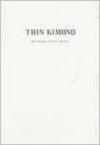Thin Kimono
In Thin Kimono, Michael Earl Craig’s third book, Craig is a kind of Whitman for post-Google America, where everything is exchangeable and incongruous elements continually collide, creating an equalizing strangeness where no one thing is more important than another. This strangeness, however, doesn’t remove Craig from the world, but rather is his method of being in the world.
In Thin Kimono, Michael Earl Craig’s third book, Craig is a kind of Whitman for post-Google America, where everything is exchangeable and incongruous elements continually collide, creating an equalizing strangeness where no one thing is more important than another. This strangeness, however, doesn’t remove Craig from the world, but rather is his method of being in the world.
As disparate as the constituent elements of Craig’s poems are, they always accrue into something. Take, for example, “The Plane,” composed of twelve tercets, each providing haiku-like observations regarding the mundanely surreal nature of air travel. In one, he writes, “The girl next to me is Russian. / […] / It stinks in here like anchovy vinaigrette.” In another, “The man in 13C says ‘ballsy’ / twice in five minutes.” In yet another, “I’m looking out the window at the wing again. / It’s like looking into someone’s / girlfriend’s ear, as she’s sleeping.” Craig ends with the lines, “When people use the word ballsy / it always makes me smile. Far off / below, the snow-dusted mountains.” Here, Craig gives us irregular observations that, instead of robbing us of “meaning,” posit that irregularity as meaning.
The way these poems discern meaning in the disjointed, awkward, and misplaced allows Craig to find his truths in unassuming places. In “After a Terrifying Nap,” a grasshopper “glanced in through the open / window of a southbound car, / hit the fleeced shoulder of / a sleeping infant and bounced / down onto the floor,” where it “came to rest beside a potato chip.” The scene manages to be bizarre and commonplace at the same time. Yet, it’s this moment Craig makes profound. He writes:
The grasshopper sent forth a golden light.
The infant awoke in his car seat,
looked at the grasshopper
and wiggled his feet, his white socks.
It is likely we are completely ignorant
of our role in the universe.
However, the “truths” Craig discovers are meant not to explain the world, but rather, preserve its strangeness. Craig ends the collection with “City at Night.” The speaker, after being “punctured” by his acupuncturist, is left alone in the dark of the “crucifix room” where every square inch is covered with crucifixes. The speaker states:
I was a city at night on the banks of a river.
The various crucifixes flashed a little
in the moonlight, sound of water lapping.
There were a thousand struggling souls in that city.
Usually they’d be crying out to God.
But this particular night they quietly let
the blue light go coursing through the parks,
past auto dealerships, past bakeries,
through hospital courtyards, down the long alleys,
through the train station and each of the train cars.
After awhile God called down to them.
He hadn’t heard from them.
It was all very strange to him.
For Craig, there are no truths which don’t acknowledge how little we could ever know of the world, and how beautiful a place it is as a result.
If Michael Earl Craig is the Whitman of the post-Google era, then Thin Kimono is his Leaves of Grass. If you want to find him, look for him under the discarded bag of Lays, or in your crucifix room, or in the aisle across from you on your flight from Boise to Beijing.





